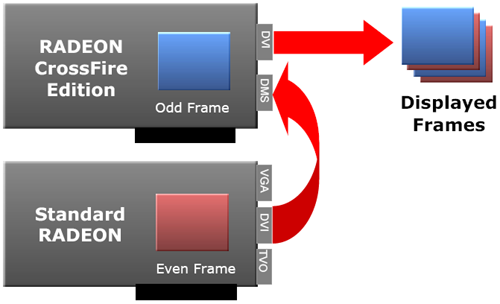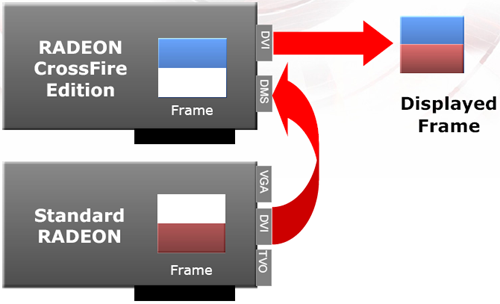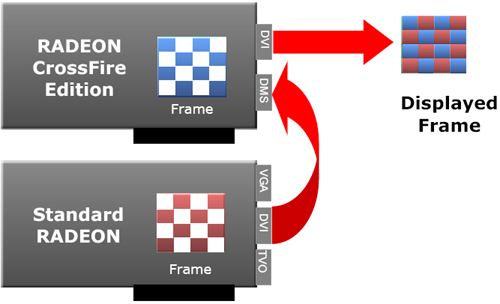ATI's Multi-GPU Solution: CrossFire
by Anand Lal Shimpi & Derek Wilson on May 30, 2005 9:00 PM EST- Posted in
- GPUs
Rendering Modes
The task of getting two separate video cards to handle drawing frames efficiently for a single application transparent to the programmer and end user is quite an undertaking. When life was fillrate limited, 3dfx solved the problem by having each card render odd and even scanlines, which were then combined in analog. This solution is no longer viable, but ATI and NVIDIA have both come up with ways to accomplish the goal.The absolute most desirable mode of operation that both companies have come up with is alternate frame rendering (AFR). As the name implies, each card renders an entire, separate frame. The major advantage to allowing each card to render an entire frame is that each card is able to handle the geometry processing required as well as the pixel processing.

Alternate frame rendering can't always be used for various reasons (such as the case when one frame depends on the previous result). When alternate frame rendering cannot be used, splitting the current frame vertically is an alternative that both ATI and NVIDIA have implemented. When the work for a single frame is split between two cards, the geometry pipeline can't be divided as easily as the pixel pipeline. As a scene is being rendered, it is not easy to assign objects to different cards as all objects in a scene can affect any of the pixels.

After geometry is sorted, a guess can be made as to how much pixel power will be required for different areas of the screen, and NVIDIA takes advantage of this to distribute the workload more evenly across the two cards. If the top half of the screen isn't as difficult to render, more than half the screen is given to the card assigned to the top. This method definitely helps to keep cards rendering split frames evenly loaded. ATI is capable of splitting the rendering work 60/40 or 70/30 under their scissor mode, but the split is determined per application.

Evenly dividing work is a very important task, and ATI has taken it a step further with CrossFire. They are introducing a rendering mode, which they call Supertiling. This mode splits the entire screen up into 32x32 pixel tiles and hands out a checkerboard pattern to each graphics card for pixel processing. Doing this effectively takes the guess work out of load balancing pixel processing between two cards. The workload averages itself out when the cards share the pixels in areas so near each other.
The caveat of Supertiling is compatibility. It has come to our attention that the "small number of applications" for which Supertiling does not work includes all OpenGL based titles. This means that OpenGL has either AFR or split frame rendering options available. AFR is the most desirable mode, but it would be nice to have a middle ground with more effective load balancing.
In addition to these multi card render modes, ATI has gone a step further to include enhanced AA modes. This is made possible by taking advantage of programmable sample points and their hardware compositing engine.










57 Comments
View All Comments
Pollock - Tuesday, May 31, 2005 - link
Looks interesting to me, at least so far. I'll agree that we still have to see how things turn out.Eug - Tuesday, May 31, 2005 - link
Crossfire? Meh. About 0.1% of the population will buy dual GPU setups. Crossfire is essentially just a marketecture exercise.The really interesting part is the H.264 acceleration, which will have much, much more impact for the general computing world than Crossfire.
nitromullet - Tuesday, May 31, 2005 - link
Interesting... They gave AT stock photos of a Intel based motherboard, but the benchmarking was done on an AMD rig. Anyone know if the chipset(s) support Athlon X2 and/or Pentium D?To the person that mentioned that Doom3 is not a good benchmark for ATi: My guess is that Doom3 is probably a good benchmark to use for this purpose. ATi is most assuredly GPU bound in Doom3, so any increase in GPU power will yield a positive result. Whereas in HL2 where ATi has really strong single performance, I would imgaine that the Crossfire rig is CPU lmited, so there is not as drastic of an increase.
Either way, Crossfire looks to be pretty interesting. Can't wait to see some in depth benches and some screenies of the super AA modes.
A request to AT: how about some benches in standard and widescreen resolutions. I know that SLI had compatibility issues with widescreen in the past, and it would be nice to know if those are still around and/or if Crossfire also suffers from this.
Nice article, especially with the limitation of not being able to run a full suite of benchmarks.
jiulemoigt - Tuesday, May 31, 2005 - link
So what about the fact the new mode does not work in OpenGL? I happened to love playing with directX api but knowing that half the engines will not be able to use the new filtering? I like the idea of the new chip they are putting on the board, I'm disguested most of the ATI stuff is marketing not hardware I have to develope for the hardware in peoples machines and the baises that people have toward tech and i'm getting sick of finding a new way of doing something not being able to use it because it only works on nvidia and ati bashes till they sorta get it working then they claim it's the best thing since sliced bread. Lets try and force nvidia and ati marking people to focus on what is there not what there side has.DerekWilson - Tuesday, May 31, 2005 - link
I suppose we should add a disclaimer to the statement about Super AA working with everything ...From what we *hear* from ATI, all games will work with CrossFire. This means that all games will work with at least one of the performance or quality modes. Even if a game doesn't work under AFR, split, or supertiling, it should work with Super AA ...
But we will have to test compatibility for ourselves.
Derek Wilson
porkster - Tuesday, May 31, 2005 - link
I can't see why they can't just use one PCIe card with a extra socket. Wheny ou ened to upgrade for more power then you buy just the chip and put the extra GPU chip in the socket to make a dual graphics card.SLI is a waste of time in that it's a direction in motherboard layout that isn't going to last, it's a dead end road for the future. So rather than was all the time developing cards that work in tandom, make the card to work with more GPU chip ont he same daughter board.
.
AdamK47 3DS - Tuesday, May 31, 2005 - link
"all games will be accelerated under any Super AA mode"I hope Anandtech isn't pulling my leg here. I'd love to see Halo PC or Splinter Cell using AA. Currently no form of multisampling allows AA in these games. There are probably more games out there that have the same multisampling limitation, but these are the two I know of.
matthieuusa - Tuesday, May 31, 2005 - link
And should I had that investors seems to feel like ATI is taking its place back. NVDIA stocks already dropped 59 cents witht the announcement of ATI crossfire and R520 playback display...#37: totally agree, it is going to be a nice fight! If R520 is overall better than the G70, NVDIA will have to worry and counter it as fast as they can (which is going to be great for us).
matthieuusa - Tuesday, May 31, 2005 - link
I agree with #35. It is a little early to know which solution will be considered the best, even if it seems that ATI is bringing sone very interesting features along with their Crossfire. Not everybody care about playing Doom3 at 110 fps. I rather play at 80fps and have all the eye candies, and even more, since they are going to propose heavier FSAA.Since SLI and Crossfire will probably come to be close, it is going to see which one of the r520 and g70 will be the fastest with the most interesting features. But if ATI did as good with the R520 as they seem to have done with the Crossfire, they could take back the crown.
NVIDIA seems in hurry to put the G70 on the shelves, which seems kind of suspect, since there is are no real reasons to do so. They acually do have the most popular cards and the fastest configuration with SLI.
Did they heard about ATI R520 specs and fear to be at a disadvantage? Do they need two G70 to beat it?
Wait and See
#36 2PCI-E 8X -> that is exactly what SLI is right now with NVDIA.
Compositing Engine chip -> Do you remember the discussion about the PCI-E bridge implemented on GeForce 6 cards? Experience has shown no performance drop. Instead, in ATI's "SLI" solution, it seems even better since it is not part of the die -> less heat... It is not new to them, since there are using it in professionnals products
kyaku00x - Tuesday, May 31, 2005 - link
I think the next chipset king will be the one producing the best next-gen graphics cards. if NV70 is better performing than r520 then I wouldn't think that people are going to care about going ATI in the mobo department, but if r520>nv70, then nvidia may start losing the chipset market.this will be real interesting to watch, the first chipset war determined by graphics cards :P